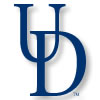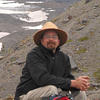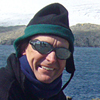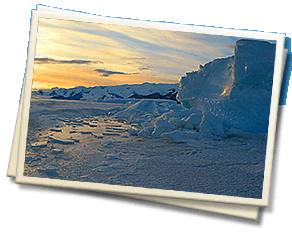
Check out the latest news about the University of Delaware's polar research and public events. For more news about University of Delaware research, visit www.udel.edu/research.

6:05 p.m., Feb. 23, 2009--“Nanook
of the North,” the silent film released in 1922 documenting the life of
the Inuit people in Arctic Canada, will be presented Sunday, March 1,
at 7:30 p.m. in Trabant University Theatre. The film, the first feature-length
documentary, was produced by American filmmaker Robert Flaherty.

3:13 p.m., April 6, 2009--The
American Geographical Society's awards ceremony on Wednesday, April
15, at the University of Delaware will honor past and present polar
explorers - of this planet and of Mars. Also recognized will be the
researchers who oversaw the gargantuan task of relocating the society's
library, described as “the largest privately owned geographical research
collection in the western hemisphere,” from New York to Wisconsin
in the 1970s.

4:17 p.m., March 24, 2009--“Nanook
of the North,” the silent film released in 1922 documenting the life of
the Inuit people in Arctic Canada, will be presented Sunday, March 1,
at 7:30 p.m. in Trabant University Theatre. The film, the first feature-length
documentary, was produced by American filmmaker Robert Flaherty.

9:58 a.m., March 10, 2009--The
University of Delaware's Arctic research and educational resources are
featured in a special insert in the current edition of Witness the Arctic,
the biannual newsletter published by the Arctic Research Consortium of
the United States (ARCUS).

11:48 a.m., March 4, 2009--The
Iñupiaq people of Alaska live in the northernmost regions of the United
States and the North American mainland, including the city of Barrow,
the most northern U.S. city. In this harsh Arctic environment, the bowhead
whale is central to Iñupiaq life and culture. In fact, the Iñupiaq identify
themselves as the “People of the Whales.”

6:05 p.m., Feb. 23, 2009--“Nanook
of the North,” the silent film released in 1922 documenting the life of
the Inuit people in Arctic Canada, will be presented Sunday, March 1, at
7:30 p.m. in Trabant University Theatre. The film, the first feature-length
documentary, was produced by American filmmaker Robert Flaherty.

11:30 a.m., Feb. 17, 2009--The University
of Delaware has acquired a large collection of papers and records belonging
to the pioneering South Pole explorer and astrophysicist Martin A. Pomerantz.
He pioneered the use of the South Pole as a laboratory for studying
astronomy and astrophysics.

11:21 a.m., Feb. 17, 2009--When
Jerry Marty left the South Pole in December, he walked under a canopy not
of crossed swords but of crossed measuring tapes -- a fitting tribute to
the man who oversaw one of the world's most challenging construction projects,
the new South Pole Station.

2:56 p.m., Feb. 3, 2009--The latest
lectures in the University of Delaware's William S. Carlson International
Polar Year Events will take you on a journey to the ends of the Earth, from
the new U.S. South Pole Station -- an engineering marvel -- to the Arctic,
where scientists are observing changes in marine biological communities
as global temperatures warm.

3:46 p.m., Dec. 9, 2008--It's 40
degrees F below zero (with the wind chill) at the South Pole today. Yet
a research team from the University of Delaware is taking it all in stride.
The physicists, engineers and technicians from the University of Delaware's
Bartol Research Institute are part of an international team working to build
the world's largest neutrino telescope in the Antarctic ice, far beneath
the continent's snow-covered surface.

5 p.m., Dec. 8, 2008--What's it
really like to live and work in Antarctica? How cold does it get, and
what are the living quarters like at the new U.S. South Pole Station?
Find out from UD's research team working on the IceCube telescope and
its surface array of detectors, aptly named "IceTop." The scientists and
technicians are blogging now on this cool new UD Web site.

2:59 p.m., Dec. 3, 2008--What may
the world's largest neutrino telescope, aptly named “IceCube,” be able to
tell us about the universe when it's completed?Find out during “Above the
Poles,” a live event broadcast over the Web from Antarctica on Thursday,
Dec. 4, starting at 2 p.m. on the East Coast. It will involve an international
team of researchers working at South Pole Station, including Thomas Gaisser,
the Martin A. Pomerantz Chaired Professor of Physics and Astronomy at the
University of Delaware.

9:43 a.m., Dec. 2, 2008--"Encounters
at the End of the World," a Discovery Channel film about the “hidden
society” of men and women on a quest to do cutting-edge science in Antarctica,
will be presented Sunday, Dec. 7, at 7:30 p.m. in the Trabant University
Center Theater. Director Werner Herzog traveled to McMurdo Station,
home to 1,100 people during the austral summer. There, they profiled fascinating
people in this extreme environment, from the depths of the Ross
Sea to the top of Mount Erebus volcano.

8:19 a.m., Nov. 17, 2008--Bruce
Sidell, professor of marine sciences at the University of Maine, will
deliver a seminar on the Antarctic icefishes on Thursday, Nov. 20, from
3:30 p.m. to 4:30 p.m. at the Hugh R. Sharp Campus in 202 Cannon Lab and
broadcast via ITV to the Newark campus in 206 Robinson Hall. He will discuss
how the history of climate, oceanography and ecology has influenced
the evolution of these fish and describe the cardiovascular
features that allow them to deliver adequate supplies of oxygen
to their tissues.

12:04 p.m., Nov. 11, 2008--Richard
Alley, Evan Pugh Professor of Geosciences, and associate of the Earth
and Environmental Systems Institute at Pennsylvania State University,
University Park, will speak on “Ice Sheets Unplugged: The Future of Sea
Level in a Warming World,” from 5-6 p.m., Friday, Nov., 14, in 123 Memorial
Hall. Alley, an acknowledged expert on global warming and sea
level changes, discuss what we know and don't know about the future of
ice sheets and sea level.

12:57 p.m., Nov. 3, 2008-- Brian
Lanoil, associate professor of biological science at the University of
Alberta, will deliver a seminar on the world's
extreme environments, the organisms adapted to living there, and what
they can tell about the globe's environmental cycles on Thursday,
Nov. 6, from 12:30–1:30 p.m., in 202 Cannon Laboratory
on UD's Hugh R. Sharp Campus in Lewes. The presentation will be broadcast
via ITV to 206 Robinson Hall on the Newark campus.

4:15 p.m., Oct. 13, 2008--On Oct.
30, from 5-6:30 p.m. in 127 Memorial Hall at UD, Robert
McCracken Peck, curator of art and artifacts and senior fellow at the
Academy of Natural Sciences of Philadelphia, will discuss how Arctic enthusiasm
manifested itself in everyday items of material culture, from children's
card games to spectacular presentation
silver pieces depicting Inuit hunters.

11:36 a.m., Oct. 10, 2008--On Friday,
Oct. 17, at 5 p.m. at the University Gallery, UD polar researchers
Brian Hanson and Frederick "Fritz" Nelson will co-present the lecture
“Ships of Ice,” illuminating the bracing subjects of two major photographic
exhibitions on display through Dec. 7.

3:13 p.m., Oct. 7, 2008--The murder
of two priests by Eskimos, the hunt for the men who killed them by Royal
Northwest Mounted Police, and the subsequent trials of the men who confessed
are the subject of Bloody Falls of the Coppermine:
Madness, Murder and the Collision of Cultures in the Arctic in 1913, a nonfiction book written
by McKay Jenkins, the Cornelius A. Tilghman Professor of English at UD,
and published by Random House in 2005.

4:11 p.m., Sept. 26, 2008--When
Arctic explorer Elisha Kent Kane died in 1857, his was the largest funeral,
up to that time, in American history. His funeral cortege would take three
weeks to cross the country and would be met by thousands of mourners.
So who was Kane, and why did he captivate a nation? Michael Robinson,
author of the Coldest Crucible: Arctic Exploration
and American Culture, began unraveling the mystery at the University
of Delaware.

3:19 p.m., Sept. 12, 2008--The moment
that contemporary photographer Camille Seaman “met her planet” is seemingly
frozen in time, not to be forgotten, just like her evocative images of monolithic
icebergs.

1:26 p.m., Sept. 2, 2008--The
University Museums of the University of Delaware will hold two exhibitions
from Sept. 9-Dec. 7, in the University Gallery, Old College, as part of
the University of Delaware's contribution to the International Polar Year
2007-2008.

3:42 p.m., April 16, 2008--The "sleeping
giants" at the ends of the Earth--the polar ice sheets--are "awakening," Waleed
Abdalati, head of NASA's Cryospheric Sciences Branch, told an audience
of more than 200 at the University of Delaware on Thursday evening,
April 10.

4:19 p.m., Feb. 22, 2008--A daring mission in 1931 to explore the Arctic in a submarine named Nautilus, and a recent underwater expedition to rediscover the scuttled vessel, will be the focus of the next lecture in the University of Delaware's William S. Carlson International Polar Year Events, set for 3:30 p.m., Friday, Feb. 29, in Memorial Hall.

4:04 p.m., Feb. 20, 2008--For those daring souls who braved Delaware's icy terrain on Feb. 12 to see Coast Guard Capt. Lawson Brigham add his signature to the American Geographical Society's Fliers' and Explorers' Globe, the treacherous trip was well worth it.

1:39 p.m., Feb. 12, 2008--Capt. Lawson Brigham, who sailed to the polar limits of the global ocean on a voyage from Antarctica to the North Pole, will join a celebrated group of adventurers when he signs the American Geographical Society's Fliers' and Explorers' Globe at 7:30 p.m., Tuesday, Feb. 12, at the University of Delaware's Louise and David Roselle Center for the Arts.

1:34 p.m., Feb. 12, 2008--Capt. Lawson Brigham, deputy director of the U.S. Arctic Research Commission will present "Using Scenario Planning to Understand Future Arctic Marine Use" from 1:30-2:50 p.m., Wednesday, Feb. 13, in 206 Robinson Hall and via ITV in 202 Cannon Lab on UD's Lewes campus.

4:34 p.m., Feb. 5, 2008--Capt. Lawson Brigham, who sailed to the polar limits of the global ocean on a voyage from Antarctica to the North Pole, will join a celebrated group of adventurers when he signs the American Geographical Society's Fliers' and Explorers' Globe on Tues., Feb. 12, starting at 7:30 p.m. at the University of Delaware's Louise and David Roselle Center for the Arts.

5:05 p.m., Jan. 17, 2008--As the globe turns, you see their names--the autographs of an elite group, the world's foremost explorers and aviators. There's the signature of Amelia Earhart, the famed aviatrix; Robert Peary and Roald Amundsen, first to reach the North and South Poles; Sir Edmund Hillary, the first to scale Mt. Everest; Neil Armstrong, the first to set foot on the moon. One legendary pioneer after another.

3:47 p.m., Jan. 9, 2008--Being away from home during the holidays is always hard, and this is especially true at the literal end of the earth, the South Pole. Here, satellite connectivity for Internet and domestic phone calls is available only eight hours each day. This community of 250 people, living at 10,600 feet on the world's largest ice cap, braving -20 degree summer temperatures, has developed a unique camaraderie that may be as friendly and comforting as this location is harsh.

4:17 p.m., Jan. 8, 2008--For 25 UD students and their two professors--Jacob Bowman, associate professor of entomology and wildlife ecology, and Jonathan Cox, supplemental art faculty--Friday, Jan. 4, was not a typical first day of class. At 4 p.m., they boarded a plane at New York's JFK airport heading for Argentina and Antarctica as part of the University of Delaware Winter Session Study Abroad Program.

a.m., Dec. 19, 2007--We left South Pole Station yesterday on time. I was lucky again to get to ride in the cockpit of the C-130 all the way from Pole (NPX) to McMurdo (MCM). I think I now have more flight time in the cockpit of a C-130 than I do in a Cessna! I really need to remedy that and finish my pilot license!

a.m., Dec. 17, 2007--When I first arrived here, we had temperatures of -40¡ or lower every day. During the last week, there has been a warming trend. The temperature has warmed to -24¡C, but the wind has picked up. Yesterday, the winds were at 26 knots. All of the pictures I have sent so far showed blue skies, but add 26-knot winds and you have a whiteout!

a.m., Dec. 11, 2007--The routine for leaving South Pole calls for checked baggage to be packed and available for collection in the hallway of the station at 7:30 p.m. the day before scheduled departure. This year, everything went according to schedule, which is not always the case....

11:15 a.m., Dec. 7, 2007--Most of you have read about IceCube or IceTop earlier in this series. For those who haven't, we are building the world's largest Neutrino Telescope here at the South Pole. Neutrinos are incredibly hard-to-detect particles, so we need a really big detector. IceCube, when finished, will use a cubic kilometer of South Pole ice to capture the light signal left by neutrinos that have passed entirely through the Earth. Neutrinos point directly back to their source, so they will help us map the Northern sky in ways that have never been seen before.

11:15 a.m., Dec. 1, 2007--Editor's note: Over the next few weeks, with support from the National Science Foundation, a team of University of Delaware researchers will be at work in one of the iciest, coldest, most austere places on the planet: South Pole, Antarctica. Currently stationed at the South Pole are UD researchers Thomas Gaisser, Stoyan Stoyanov, and James Roth of UD's Bartol Research Institute, who are working on the IceCube neutrino telescope.

11:15 a.m., Nov. 30, 2007--Over the next few weeks, with support from the National Science Foundation, a team of University of Delaware researchers will be at work in one of the iciest, coldest, most austere places on the planet: South Pole, Antarctica. Currently stationed at the South Pole are UD researchers Thomas Gaisser, Stoyan Stoyanov, and James Roth of UD's Bartol Research Institute, who are working on the IceCube neutrino telescope.

11:30 a.m., Nov. 26, 2007--Over the next few weeks, a team of University of Delaware researchers will be at work in one of the iciest, coldest, most austere places on the planet: South Pole, Antarctica. Currently stationed at the South Pole are UD researchers Thomas Gaisser, Stoyan Stoyanov, and James Roth of UD's Bartol Research Institute, who are working on the IceCube neutrino telescope. Their Antarctic blogs will appear on UDaily and on the Wilmington News Journal's Delaware Online Web site through a partnership between UD and the newspaper.

8:30 a.m., Nov. 26, 2007--Over the next few weeks, a team of University of Delaware researchers will be at work in one of the iciest, coldest, most austere places on the planet: South Pole, Antarctica. Currently stationed at the South Pole are UD researchers Thomas Gaisser, Stoyan Stoyanov, and James Roth of UD's Bartol Research Institute, who are working on the IceCube neutrino telescope. Their Antarctic blogs will appear on UDaily and on the Wilmington News Journal's Delaware Online Web site through a partnership between UD and the newspaper.

1:20 p.m., Nov. 21, 2007--Researchers from the University of Delaware and the University of California at Riverside have thawed ice estimated to be at least a million years old from above Lake Vostok, an ancient lake that lies hidden more than two miles beneath the frozen surface of Antarctica.

8:30 a.m., Nov. 20, 2007--Over the next few weeks, a team of University of Delaware researchers will be at work in one of the iciest, coldest, most austere places on the planet: South Pole, Antarctica. Currently stationed at the South Pole are UD researchers Thomas Gaisser, Stoyan Stoyanov, and James Roth of UD's Bartol Research Institute, who are working on the IceCube neutrino telescope. Their Antarctic blogs will appear on UDaily and on the Wilmington News Journal's Delaware Online Web site through a partnership between UD and the newspaper.

1:52 p.m., Nov. 16, 2007--Over the next few weeks, a team of University of Delaware researchers will be at work in one of the iciest, coldest, most austere places on the planet: South Pole, Antarctica. Currently stationed at the South Pole are UD researchers Thomas Gaisser, Stoyan Stoyanov, and James Roth of UD's Bartol Research Institute, who are working on the IceCube neutrino telescope. Their Antarctic blogs will appear on UDaily and on the Wilmington News Journal's Delaware Online Web site through a partnership between UD and the newspaper.

9:07 a.m., Oct. 8, 2007--Michael O'Neal, an assistant professor of geography at UD who recently returned from a two-week field trip studying glaciers in the Cascade Mountain Range, describes a typical day of research: A five-mile vertical hike kicks things off. Careful note-taking fills most of the daylight hours. The hike back to camp (at an elevation of 3,000 feet) completes the cycle. And at the end of the trip, the thoroughgoing data will be inconclusive. Two weeks in the life of millennia-old glaciers is a very short span, after all.

3:49 p.m., July 13, 2007--Three scientists--two with close ties to the University of Delaware--lived in a frigid ice camp this spring as part of a $1.4 million National Science Foundation project they have dubbed SEDNA, for Sea-ice Experiment: Dynamic Nature of the Arctic.

3:15 p.m., July 13, 2007--University of Delaware scientists played key roles in a National Science Foundation-funded spring project to better understand the motion and deformation of Arctic sea ice through fieldwork, satellite imaging and computer modeling.

2:34 p.m., June 15, 2007--James Roth, a senior electronics and instrumentation technician in UD's Department of Physics and Astronomy, recently completed his fourth season in Antarctica, working on UD's “IceTop” project. His blog from the South Pole on Jan. 15 provides insight into what it's like to live and work on the harshest continent on the planet.

11:22 a.m., June 1, 2007--UD marine scientist David Kirchman has sailed among glaciers, walked with penguins, swum in the same icy waters as polar bears, and seen ice-covered mountains so majestic they've taken his breath away. He is a veteran of scientific research cruises in the freezing waters of both the Arctic and the Antarctic, with more exciting voyages ahead in the International Polar Year.

3:18 p.m., May 23, 2007--"IceCube" is a gigantic scientific instrument--a telescope for detecting illusive particles called neutrinos that can travel millions of miles through space, passing right through planets.

4:45 p.m., March 2, 2007--The world is marking the fourth International Polar Year from March 2007 to March 2008, providing a time to reflect on the importance of the frozen reaches in the Arctic and the Antarctic to the health of the planet and to consider the implications that the changing climate in those regions may have around the globe.

9:52 a.m., Dec. 21, 2006--Two University of Delaware professors are co-principal investigators in a National Science Foundation (NSF)-funded project to understand how changes in temperature and nitrogen deposition affect tundra ecosystems. Barbara Campbell and Thomas Hanson, both assistant professors of marine and earth studies, recently returned from the Arctic Long Term Ecological Research (LTER) station at Toolik Lake in Alaska where they collected samples for the study.


